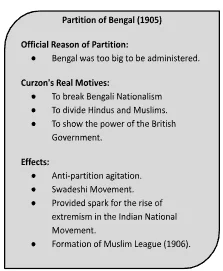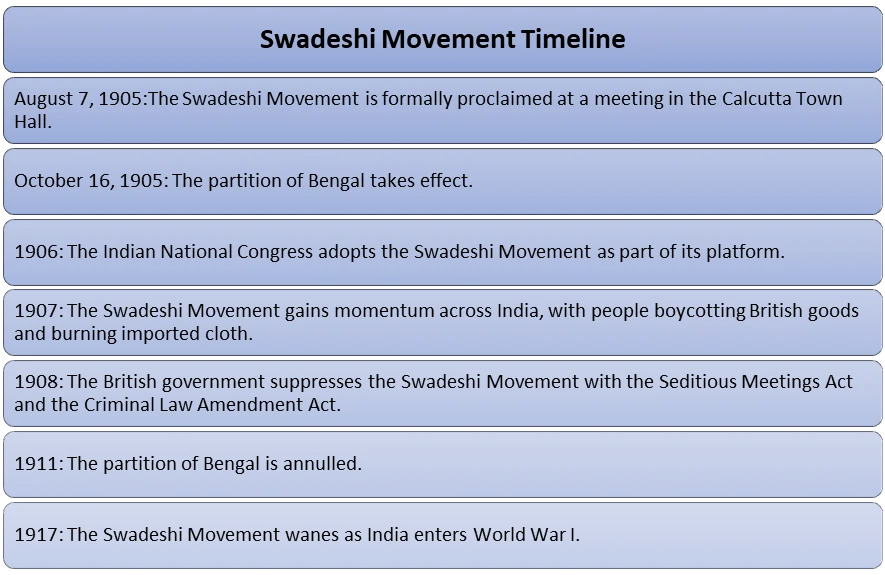The Swadeshi and Boycott Movement was pivotal in India’s struggle for independence from British colonial rule during the early 20th century. It was a powerful expression of nationalist sentiment and a call for economic self-sufficiency. Initiated in 1905, the movement urged Indians to use ‘Swadeshi,’ or promote locally-made goods, while simultaneously ‘Boycotting’ British-made products. Led by prominent leaders like Bal Gangadhar Tilak and Lala Lajpat Rai, it aimed to hit the British Empire economically and instill a sense of self-reliance among the Indian population. This movement not only impacted India’s political landscape but also laid the foundation for a stronger and more unified nationalist movement against British colonialism.
Partition of Bengal to Divide People
The Swadeshi and Boycott Movement was indeed sparked by the Partition of Bengal, which many Indians saw as a deliberate attempt by the British colonial authorities to divide the people along religious lines. Here’s a more detailed explanation of how the Partition of Bengal was perceived as an attempt to divide the population:

- Two distinct provinces: In December 1903, the British government announced the partition of Bengal, creating two distinct provinces.
- Bengal: It encompasses Western Bengal, Bihar, and Orissa, with Calcutta as its capital.
- Eastern Bengal: It encompasses Eastern Bengal and Assam with Dacca as its capital.
- The official explanation: The official explanation cited the difficulty in administering Bengal due to its vast population of 78 million, approximately a quarter of British India’s total population. The government also claimed that this partition would aid in the development of Assam under direct governance.
- The true motive: Beneath these stated reasons lay a more covert objective. The true motive behind the partition appeared to be the British strategy to undermine the stronghold of Indian nationalism, i.e., Bengal. This was to be achieved by splitting the Bengalis into two administrations, thereby diminishing their influence.
- Linguistic Division: The division was based on language, reducing Bengalis to a minority within Bengal itself. In the proposed plan, Bengal proper would house 17 million Bengalis, while 37 million Hindi and Oriya speakers would dominate.
- Religious divisions: Additionally, the partition relied on religious divisions, with the western region becoming a Hindu majority area (42 million out of 54 million) and the eastern section a Muslim majority area (18 million out of 31 million).
- Attempted to appeal to the Muslims: The Viceroy at the time, Lord Curzon, attempted to appeal to the Muslims by proposing Dacca as the capital of the new Muslim-majority province, aiming to invoke a sense of unity reminiscent of historic Muslim rulers.
- It became evident that the government intended to pursue its long-standing policy of supporting Muslim communalists to counteract the Congress and the burgeoning national movement.
The Partition of Bengal made by Lord Curzon in 1905 lasted until Home Secretary Herbert Risley made his point clear in his note that “Bengal united is a power” and “Bengal divided will pull in several different ways.”
| “Real Awakening in India occurred only after the Partition of Bengal.”
-M. K. Gandhi “What we could not have accomplished in 50 or 100 years, the great disaster, the partition of Bengal has done for us in six months. Its fruit has been the great national movement known as the Swadeshi Movement.” Abdul Rasul, President of Barisal Conference |
Swadeshi Movement
The Swadeshi Movement, starting in the early 20th century, marked a significant moment in India’s struggle for independence. It saw active participation from diverse groups like women, students, and both urban and rural populations in Bengal and across India. Over five years, a wide range of political ideologies emerged, from moderation to extremism, terrorism to socialism, and various forms of protest. This movement not only impacted politics but also triggered a cultural renaissance in literature, music, science, and industry.
| Desher Katha:
The book “Desher Katha” written by Sakharam Ganesh Deuskar: In overwhelming detail, the book “Desher Katha” summarised the work of M. G. Ranade and D. Naoroji in a popular idiom and warned in its concluding chapter against the colonial state’s “hypnotic conquest of the mind”. Deuskar uses the word ‘desh’ in the context of the whole country. “Desher Katha” had immense repercussions in Bengal, captured the mind of young Bengal, and assisted more than anything else in the preparation of the Swadeshi Movement. It inspired the performance of Swadeshi street plays and folk songs. |
Responsible Factors for the Movement
The Swadeshi and Boycott Movement in India, which began in response to the partition of Bengal in 1905, had several significant causes and motivations. These causes included:
- Partition of Bengal: The immediate cause of the Swadeshi and Boycott Movement was the controversial decision by the British colonial authorities to partition the province of Bengal in 1905.
- This move was perceived as a deliberate attempt to divide the Hindu and Muslim populations of Bengal along religious lines, which created widespread anger and opposition.
- Nationalism and Patriotism: The early 20th century witnessed a rising tide of nationalism and patriotism in India. Indian leaders and intellectuals felt a growing sense of pride and a desire for self-governance.
- The partition of Bengal catalyzed this nationalist sentiment.
- Economic Exploitation: Indians were dissatisfied with the economic exploitation by the British colonial administration.
- The drain of wealth from India to Britain and the unfair economic policies imposed on Indians led to economic hardship for many.
- Political Repression: The British colonial government was repressive. It had denied the Indian people basic political rights and had imprisoned many Indian leaders.
- The Swadeshi and Boycott Movement was also a protest against the political repression of the British government.
Various Aspects of Swadeshi Movement
- Cultural Identity: The movement aimed to preserve and promote India’s cultural identity and heritage.
- It emphasized the revival of traditional Indian handicrafts and industries and the use of Indigenous goods over British-manufactured products.

- Leadership and Inspiration: The movement had charismatic leaders like Bal Gangadhar Tilak, Bipin Chandra Pal, and Lala Lajpat Rai, who inspired and mobilized the masses with their impassioned speeches and writings.
- Boycott of British Goods: The movement advocated for the boycott of British-manufactured goods, which was seen as a form of protest against British economic exploitation.
- Indians were encouraged to use Swadeshi (indigenous) products and avoid British imports.
- Promotion of Swadeshi Industries: Swadeshi meant “of one’s own country.” The movement encouraged the development and support of Indian-owned and Indian-operated industries.
- This was seen as a means of economic empowerment and self-reliance.
- Political Awareness: The Swadeshi Movement played a significant role in raising political awareness among the Indian masses.
- It was a precursor to more extensive political movements and played a pivotal role in the larger struggle for independence.
- Solidarity across Communities: The movement brought together people from diverse religious and social backgrounds, uniting Hindus and Muslims in common opposition to British policies.
- It fostered a sense of unity and collaboration among Indians.
- Intellectual and Cultural Awakening: The movement was accompanied by a cultural renaissance that saw the promotion of Indian languages, arts, and literature.
- Many poets, writers, and artists contributed to this cultural awakening.
The Congress’s Position
The Indian National Congress played a significant role in the Swadeshi and Boycott Movement, supporting and participating in various capacities throughout its course. Here’s an overview of the Congress’s position and involvement in the movement:
- Initial Response under Moderate Leadership: The Indian National Congress initially responded cautiously to the Swadeshi Movement, fearing that it might escalate into violence and disrupt its moderate approach to seeking reforms from the British government. The Congress was concerned about maintaining its image as a responsible political organization.
- Hesitation under Moderate Leadership: At the time, the Congress was under the leadership of moderate leaders like Gopal Krishna Gokhale.
- These leaders were initially hesitant about endorsing the Swadeshi Movement, but they also recognized the widespread popular support for it.
- Hesitation under Moderate Leadership: At the time, the Congress was under the leadership of moderate leaders like Gopal Krishna Gokhale.
- Bal Gangadhar Tilak and Extremists Demands: Prominent leader Bal Gangadhar Tilak was a part of the extremist faction within the Congress. Tilak’s advocacy for more direct and assertive action against British rule aligned with the spirit of the Swadeshi Movement.
- Ideological Rift: The ideological differences within the Congress regarding the Swadeshi Movement and the use of more assertive methods of protest led to a split in the Congress during its Surat session in 1907.
- The extremist faction led by Tilak clashed with the moderates.
- Two separate Congress organizations emerged—the Indian National Congress (Moderates) and the All-India Congress (Extremists). The Extremists, influenced by the Swadeshi Movement, advocated more aggressive forms of protest and self-reliance.
- Ideological Rift: The ideological differences within the Congress regarding the Swadeshi Movement and the use of more assertive methods of protest led to a split in the Congress during its Surat session in 1907.
- Congress’s Evolving Stance: Over time, the moderate leaders within the Congress began to recognize the widespread appeal and significance of the Swadeshi Movement. The popular support for Swadeshi and Boycott grew, and this movement played a crucial role in raising political awareness among the masses.
- Reconciliation and Strategic Shift: The split between the moderates and extremists in the Congress was eventually healed, and the two factions came together again.
- The Swadeshi Movement contributed to a shift in the Congress’s approach, with greater acceptance of more assertive tactics and mass mobilization.
- Support for Boycott and Swadeshi: The Congress started actively supporting the boycott of British goods and the promotion of Swadeshi products as a part of its political program.
- These actions were seen as an effective means of economic and political protest against British rule.
- Reconciliation and Strategic Shift: The split between the moderates and extremists in the Congress was eventually healed, and the two factions came together again.
The Swadeshi and Boycott Movement, with the support and participation of the Congress, played a significant role in the political awakening of the masses in India. It contributed to the growth of the nationalist sentiment and the demand for self-rule.
| Swadeshi Movement | |
|
|
|
|
| Must Read | |
| Current Affairs | Editorial Analysis |
| Upsc Notes | Upsc Blogs |
| NCERT Notes | Free Main Answer Writing |
Conclusion
The Swadeshi Movement, which began in the early 20th century, evolved as the mass-based movement started to decline around mid-1908. Frustration and disillusionment among the youth, who had been actively involved, led to the emergence of revolutionary terrorism. This “individual heroism” marked a departure from earlier collective actions. The movement pioneered new methods for mass mobilization, leaving a valuable legacy that later stages of the national movement drew upon. It was just the initial phase in the long struggle for Indian independence, as described by Antonio Gramsci, with its impact and methods resonating through subsequent phases of the Indian freedom movement.
Sign up for the PWOnlyIAS Online Course by Physics Wallah and start your journey to IAS success today!
| Related Articles | |
| Swadeshi Movement: Spread, Extremist & Moderate Phase | Lala Lajpat Rai Jayanti 2024 |
| Moderates and Extremists | Bal Gangadhar Tilak |

 GS Foundation
GS Foundation Optional Course
Optional Course Combo Courses
Combo Courses Degree Program
Degree Program












